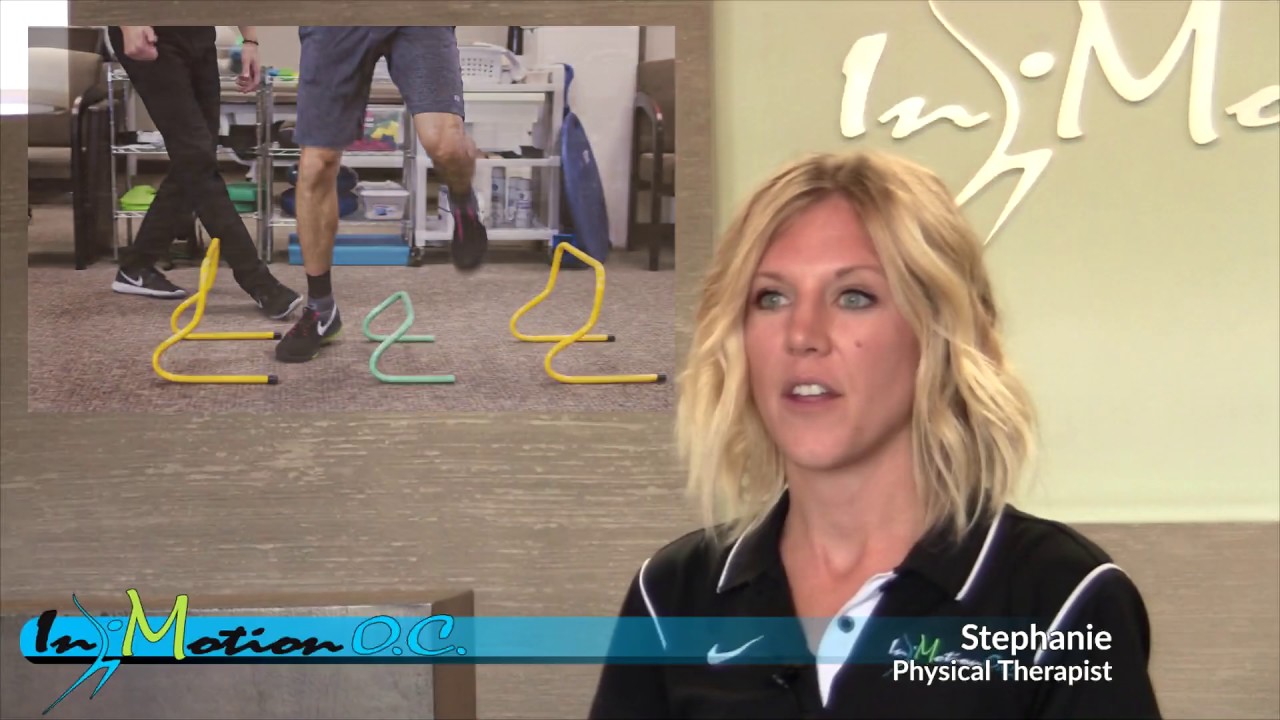Ankle/Foot
Common Ankle/Foot Ailments We Treat
- Heel Spur Physical Therapy
- Achilles Tendonitis Physical Therapy
- Drop Foot Physical Therapy
- Plantar Fasciitis Physical Therapy
- Ankle Sprain Physical Therapy
- Peripheral Neuropathy Physical Therapy
- Physical Therapy for Peroneal Tendonitis
- Ankle Fracture Physical Therapy
- Bunion Physical Therapy
- Posterior Tibial Tendonitis
- Physical Therapy for Flat Feet
- Ankle Impingement
- Physical Therapy for Turf Toe
Ankle injuries are very common. If your ankle and foot are injured, walking or moving is difficulty. Often these injuries to the ankle and foot come from poor posture and placement of our limbs when we walk, run or play sports. The way we pick up our foot and land is important; people with flattened feet and with a decreased arch may find that without the proper footwear, their feet become sore and painful to walk on. Pain and discomfort in the ankle and foot can cause compensations farther up the chain At In Motion O.C., we hope to educate our clients and potential clients on the proper mechanics of the ankle and foot.
Anatomy and Physiology of the Ankle and Foot
Just above the foot, at the base of the leg, the ankle is composed of the tibia, fibula, and talus. Layering on the bone, we add articular cartilage that protects the joint from grinding and offers support. Ligaments help to support the ankle and the other joints within the foot to cushion them from external forces and support them from dislocation or injury.
Laced in between and surrounding these ligaments, bones, and joints are muscle groups allowing the foot to plantarflex, dorsiflex, invert and evert and helping the foot and ankle propel the body forward. The topmost side of the foot is where extensors are located, and the underside of the foot is where flexors are found. Dorsiflexors allow the foot to pull upward toward the body and plantarflexors allow you to point your foot downward. Ligaments wrap the ankle and provide support. The Achilles tendon is located at the backside of the ankle and is exposed to injury often.
What is ankle and foot pain?
The feet, in comparison to our hands, have the most bones in the body, which is why these areas often suffer from a fracture. Not every person has a prominent arch in the foot, but the arch is significantly important for our posture and placement of the leg, knee and hip. Pain can start in the foot with weight-bearing and travel to other parts of the body.
When we have a shift in the foot, the ankle is offset, which then creates stress within the knee and hip above, as we well as the sacroiliac joint and back. For flat feet, patients can wear supportive shoes or orthotics that are designed to support arch in your foot, which will reset the position of the foot, ankle and everything above it. Pain in the foot can start off with cramping, tingling, dull throbbing, and cause difficulty with walking or pushing off the ground. The ankle specifically suffers from this stress and injury from rolling or twisting. Should either the foot or ankle suffer an injury, they will likely affect one another.
Main types of foot/ankle pain
Muscle Strains and Sprains
This is often due to sports-related activity. The movements of the foot affect the ankle, Acute sprains and ankle fractures can be due to the foot rolling inward or twisting outward. Sprains here can become a frequent occurrence, causing chronic pain.
Arthritis
Causes some pain that increases as the condition worsens. Arthritis in the ankle and foot can immobilize patients. Patients often feel stiffness and tenderness caused by inflammation of the ankle joint or any part of the foot.
Fractures
Any one of the 26 bones located in the foot and the ankle complex can suffer from a fracture. The ankle bones are commonly broken by twisting and inverting the ankle when we fall off balance or experience blunt injuries. Since the bones are broken up into sections in the foot, a dislocation or fracture during sports or hitting the tips of the toes on a hard surface is common.
Tendonitis and Tendonosis
Increased activity without proper stretching and care may cause tendonitis as we plantarflex and dorsiflex the ankles. Athletes suffer from stress on the Achilles possibly eventually affecting any activity.
Flat Feet, Shin Splints, and Arch Dysfunction
As discussed above, flat feet can cause a variety of problems in all joints above the foot. Shin splits are caused by an excess of pressure on the tibial bone, which is the main supporting bone in the lower leg. In contrast to a reduced arch with flat feet, an unnaturally raised arch is known as arch dysfunction where the mid-bone section in the foot suffers from strain.
Metatasalgia
Prolonged standing and improper support in our feet can cause excess pressure on the ball of the foot. Pain in this area can cause swelling and tenderness as well as shooting pain that can feel like a sudden cramp.
Morton’s Neuroma
Nerves in the foot and ankle can become stressed by compression or pinching. Nerve branches in the foot begin in the leg, run through the ankle, into separate toes and through the base of the foot. Nerves in this region are often irritated and tender, and spikes of pain shoot up through the foot and ankle.




What can you do about your ankle and foot pain?
If you are already experiencing some pain in your ankle or foot, it may be helpful to perform some stress relieving exercises that promote blood flow, healing and can increase flexibility. We encourage you to try these exercise steps below by our skilled physical therapists at In Motion O.C.
If these exercises are difficult or cause you to experience more pain, it’s best if you rest the area and elevate the leg. Ice packs and anti-inflammatory medication can reduce any swelling or tenderness in the ankle and foot. Physical therapy may help you increase mobility and reduce pain as you learn how to avoid injury with our postural program, aquatic and ACL therapy; call In Motion O.C. today to schedule your appointment at 949.861.8600.
*This information about physical therapy for ankle and foot ailments was reviewed by Dr Natalie Thomas, PT, DPT. If you have any questions, please don’t hesitate to contact us here.


